 I've been receiving tons of emails lately. I try to respond to them all, but if I haven't, it's probably because you asked a question that I thought could best be answered in a post.
I've been receiving tons of emails lately. I try to respond to them all, but if I haven't, it's probably because you asked a question that I thought could best be answered in a post.Here are a few questions that I've received lately. Maybe my responses can drum up discussions that would be helpful to everyone.
From Jennifer H...
"As I look at your pictures they seem to be much brighter than what I am using and look so much better. Could you tell me what paint, paper, and brush you use for your tempera painting? I see that you use cake tempera sometimes, too."
Hi Jennifer!
I really don't use cake tempera. Cake watercolors, yes, but not tempera. I have them in my art room but they just gather dust. I tried them once or twice and even though they are extremely efficient, I don't feel the colors are as vibrant as liquid tempera. So that may answer one of your questions.
As for what type of paint, paper and brush we use in the art room, I really don't think the brand is important. It's more about how you use what you have, than what you have.
One tip I think might be helpful is to pre-mix the liquid tempera with the right amount of water before putting it onto your palette. Make sure to use a "well-type" palette (like my plastic muffin tins) so that the kids don't need to mix the paints on their own. Colors that are the right consistency (not too watered down) help with good coverage. It also helps to have sponges on the table so kids can dab their wet brushes.
 If you are doing a tempera painting project on black construction paper, it's really important that the paint be thick (not too much water) and that the colors have a smidgen of white mixed in. This will give them the "pop" you desire.
If you are doing a tempera painting project on black construction paper, it's really important that the paint be thick (not too much water) and that the colors have a smidgen of white mixed in. This will give them the "pop" you desire.Don't be afraid to mix your tempera colors. Let's face it, the standard colors are a bit severe. Add white to the yellow to soften it up; add orange to red to create a beautiful poppy. Basically, don't throw out your old paint bottles. Mix! Mix! Mix!
Good luck Jennifer!
And to formally answer your question, these are the exact brands I use:
White Drawing/painting paper: Tru-Ray Sulphite Paper
Paint: Crayola Brand in white, black, yellow, turquoise, black, red, blue, green and brown.
Brushes: No particular brand. Just the cheapest ones I can find!
From Page K in Monroe, LA...
"Our school system does not offer art at the elementary level. So, last year I started a volunteer art mom program at the school....the students really seem to enjoy our efforts....If you have any suggestions for us that regarding projects that would be good for our tight budget and also art shows, that would be great. Oh, and we do art in the cafeteria or in the classrooms as we do not have an art room."
 Hi Page!
Hi Page!I love how you initiated the art program in your school. That's pretty much how I began...teaching in my children's classroom, then volunteering to do art nights. I do have a few tips that might be helpful:
If you are teaching in a cafeteria or place that doesn't have water, buy two large buckets. Fill one with water and leave the other empty. As kids need clean water for their painting projects, dip a small container in the clean bucket and dump dirty water in the other bucket. This works really well and allows children to be self-sufficient.
Here are a few projects that don't require much in the way of fancy supplies but are dynamic and fun:
Kinder-Second Grade
Drawing/Painting: Trucks and Tractors Turtles Pig Cow Joan Miro Flowers
Collage: City at Night Aliens
Third-Sixth
Drawing/Painting: Overlapping Bird Expressive Painting Hot Air Balloon Name Art Matisse Portraits Wild hair Line Drawing
From Jessica C
"Our standards state that the students have to make a sculpture. Do you have any suggestions for cheap/free alternatives to clay?"
Hi Jessica!
I get this question a lot. The truth is, clay is very inexpensive. At around $20 for a 50-lb slab, the clay is actually the cheapest component of ceramics. I can easily get 40-50 kids to create a project with 50 lbs of clay. The pieces don't need to be large. The problem is the underglazes, but let's face it, you need to practice frugality with these paints (saving unused portions, etc).
 Here's an option for those of you who have access to a kiln. Fire once and paint the project with acrylic paint. Basically skip the undergalze/glaze step altogether.
Here's an option for those of you who have access to a kiln. Fire once and paint the project with acrylic paint. Basically skip the undergalze/glaze step altogether.If you don't have a kiln, the option is to use air dry clay but honestly, I have never used it.
As for recycled scraps projects, the ideas are endless. Collect paper towel tubes, lunch bags and box board to create "Katrina Dolls". Or use empty boxes (cereal, toothpaste, pasta) to create a skyscraper collage. I did this with my kinders a few years back but never took pictures. Basically, paint boxes with gesso, paste onto tag board and create a 3-d skyscraper skyline. Kids can paint buildings, add stickers, decorate windows, etc.
Have you tried the standard balloon and paper machier lesson? Create jelly fish, earth, a mask, etc with this classic technique.
Anyone else have suggestions for these ladies? Please chime in!
Question Mark art by Anne Rosenvald

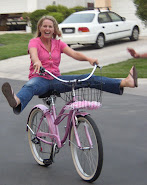






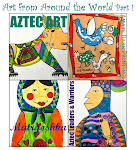
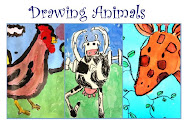
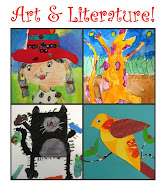


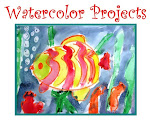





17 comments:
Great suggestions, and I love your site!
On the "cheap-ness" of clay, it really depends on what your definition of cheap is. I have a $100 budget for the whole year and teach 750 kids (k-5, 6 classes of each grade). If each grade got to do clay once, that would be $300-400! I would encourage people with the question of art budgets to try donorschoose.org. I have gotten 6 projects funded this year through them to total about $1,500 worth of stuff so far.
I don't have a sink in one of my art rooms and the clean water bucket and dirty water bucket are perfect :)
Cindy...that is appalling! How in the world can you teach that many children with $100 and how does your school district justify that? I have 4 classes of each grade, K-5 and my budget is so much higher. You have my admiration for teaching on such a ridicuously low budget.
HI, in regards to clay projects using a white clay, I decided that the children paint their ceramics with acrylic paint. I either let them use it full strength or with a little bit of white added, A great alternative is to water the paint right down ( almost wash consistency) Two to three table spoons per litre and soak the ceramic piece in the paint for a few seconds Ie dip it and remove. I use an aquamarine colour which gives it a celadon finish. Spray with a gloss sealer or use watered down PVA ( white glue) to seal. Most pieces are not not functional so this does work. But check this delightful slide show of Western Australia ceramic artist Fleur Schell and her whimisical and beautiful porcelain celadon works.
http://www.sodaresidency.com/slideshow.php or do a google image search
great site! my 4th grader really enjoyed the mead (?) lighthouse project. doing it relaxed her tremendously on what was a very stressful night for her. so thank you for posting all these beautiful projects!
Cheryl,
Very cool tip. Never watered down acrylics that much before.
Cindy,
I guess with a budget of $100, ceramics is not part of your curriculum! It would be interesting to see how you spend your budget to meet the needs of all those kids. Keep sharing! I have a feeling you have some pretty darn good tips!
I guess I'm wondering why you don't want your students to mix their own paint colors. This might not make the final projects as "adult friendly," but gives the students knowledge in creating colors and a whole lot more personal expression opportunities. "It's the process, not the product," is truly a great idea--especially at the elementary level.
Anonymous
Re: mixing paint colors. Oh, I do! But for some art projects, it's not about color mixing. Even so, the kids always mix their own colors but the colors they start out with don't necessarily have to be the standard colors in the paint containers.
I'm a big fan of having the kids use the double loading technique and mix colors on their paper. Have you tried that? The kids LOVE it.
Cindy, I can't imagine functioning with a $100 budget. What do you buy? A few reams of paper? Paint and brushes? A classpack of markers or crayons? A few bottles of glue? Impossible. Where are you that allows that kind of travesty?
Could you tell us why you called your day-of-the-dead project Katrina dolls? I know about Kachina dolls, which were made by the Hopi Indians, but when you day Katrina I think hurrican Katrina and worry about the idea of putting the name of a deadly hurricane on Day of the Dead dolls. Am I missing something?
Hi Phyl,
I have no idea why they are called katrina dolls (not kachina). I teach in a school with a large population of hispanic children and that's what they call the dolls. I'll ask some of the Latina teachers and see why the name is given. I'll post back later!
It has nothing to do with Hurricane katrina...although the name is unfortunately infamous with that event.
Thanks for the good question!
Katrina dolls is correct- I found them on the internet. and they are Day of the Dead dolls from Mexico- fascinating
Our budget is in jeopardy and I am a little bit of an environmentalist so instead of firing the clay in between bisque and glaze I let the students glaze the bisque as long as it is totally dry, and it works just the same. Saves a lot of electricity ( and time loading and unloading kilns!) I also ask parents to donate items to use such as paint brushes, glue, sponges, baby good jars, etc. I always get a great response!
love the blog by the way!
Just posted a follow up to these comments today. Check out the Form-based art lesson post.
I use the crayola air dry clay all the time, but I don't teach a lot of students and its a bit more expensive...but it does work well and produce great pieces. I paint with either tempera or acrylic and always seal with a gloss varnish. We've done pinch pots, faces, crosses, plaques, etc.., and they always turn out nice.
We used recycling materials to build sculptures- with 4th graders. we had 3 adults be in charge of hot glue guns, for faster adhering. We've also done a 2 lit. soda bottle fish project, where you cut the back of the bottle off and cut in two fins and a tail. The you need a sharpie and either acrylic paint mixed with non drip glue, or you can use FX gel markers by Crayola. kids color or paint the INSIDE and use the Sharpie to draw detaisl, scales, eyes on the outside. Poke a hole through the top, attach a string, and voila -tropical fish- We get lots of positive comments about these fish, we've done it in 3rd and 5th grade.
Our school has an art docent program (parent volunteers), and we have a 50 minute time slot for art, once per month. (teachers often give us extra time to finish) so when we paint we don't mix paints, unless it is a color or paint mixing lesson.
With regards to sulphite paper, What is sulphite paper, and how is it different from other paper?
I am very grateful for this blog, used several lessons already. I'm not a proffesional teacher, so I can use al the help I can get! The best encouragement I get is when the kids see me at school, they come up to me and ask " are we doing art today?" I grew up with art- 2hours per week, from K into high school, in Europe. I don't understand why here it is not considered "basic education" I think it should be, and thats' why I'm volunteering as art docent.Thanks for for blog and tips everyone,
Anne L.
I do clay with my K-2 students and I have a kiln. I have about 700 students so glazing and re-firing is out of the question. My solution is to use construction paper crayons and time permitting paint over with black ink or paint or blue paint. The kids love this look and they love the colors. They also love the feel of the crayons on the bumpy dried clay. A texture lesson too of sorts if you want to stretch it. I then use the clear spray or watery glue to seal the clay pieces. When firing I also pile as many pieces in the kiln as I can...place things on top of each other...just load it to the top. I've only had two to 3 pieces in 10 or so years to break so that's a pretty fair record.
As for the air dry clay...it is wonderful, but it is very hard to pull apart and get in a workable size, I felt. I love your blog and I refer to it a great deal. Thanks!
Post a Comment